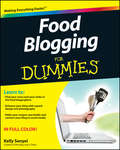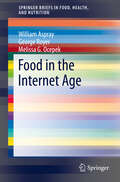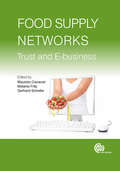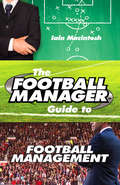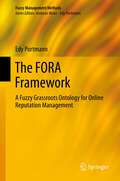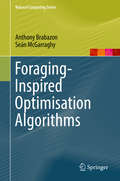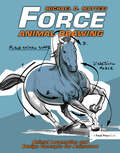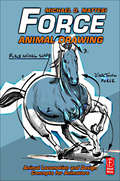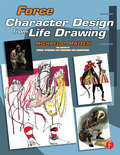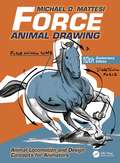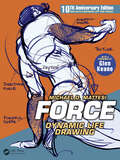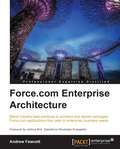- Table View
- List View
Food Blogging For Dummies
by Kelly SenyeiBloggers and foodies everywhere will want this full-color book The only thing better than cooking and eating is talking about it! Combine your two loves—food and blogging—with this ultimate guide for food bloggers everywhere. Food Blogging For Dummies shows you how to join the blogosphere with your own food blog. This unique guide covers everything: how to identify your niche, design your site, find your voice, and create mouthwatering visuals of your best recipes and menus using dazzling lighting and effects. You'll learn how to optimize your blog for search, connect with social media, take your blog mobile, add widgets, and much more. Walks you through the technicalities of starting your own food blog Explores what you need to consider before your first post ever goes public Shows you how to create lip-smacking food visuals using special lighting and clever effects Explains SEO and how to make sure your site and recipes are searchable Goes into social media and how to use it effectively with your blog Here's everything you need to know about food blogging.
Food in the Internet Age (SpringerBriefs in Food, Health, and Nutrition)
by William Aspray George Royer Melissa G. OcepekThis book examines food in the United States in the age of the Internet. One major theme running through the book is business opportunities and failures, as well as the harms to consumers and traditional brick-and-mortar companies that occurred as entrepreneurs tried to take advantage of the Internet to create online companies related to food. The other major theme is the concept of trust online and different models used by different companies to make their web presence seem trustworthy. The book describes a number of major food companies, including AllRecipes, Betty Crocker, Cook's Illustrated, Epicurious, Groupon, OpenTable, and Yelp. The book draws on business history, food studies, and information studies for its approach.
Food Supply Networks: Trust and E-business
by Gert Jan Hofstede Nicola Cantore Rainer Haas Lisa House Aris Matopoulos Rodney Bray Oliver MeixnerWhen relations are facilitated by communication technologies such as e-business, food supply networks can improve efficiency, flexibility and effectiveness. However, a lack of trust within such transactions can prevent the integration of e-business into this large, economic sector. Using case studies from European countries, chapters discuss trust-building methods for food networks in an e-business environment. Key issues include the influence of cultural disparity and cross-border transactions upon major product groups such as meat, cereal products and fresh produce.
The Football Manager's Guide to Football Management
by Iain MacintoshThe Football Manager Guide to Football Management is for anyone who has ever believed that they could do a better job than their club’s manager. It’s for anyone who has ever tried to prove that point by taking the hot seat in the management simulation Football Manager. Whilst most Football Manager players feel they possess innate tactical awareness, on point man-management skills and a gift for dealing with the media; even the most hardened fan would have to admit there’s much to be learned from those who ply their trade in the real world. If you want to make an immediate impact on your struggling hometown club, you need to refer back to Sir Bobby Robson. If you want to lay down the law with your young players, you need to take tips from Sir Alex Ferguson. Want to avoid a financial catastrophe? Then learn from Leeds United!So if, at any point in your life, you have imagined yourself in a tracksuit, waving your arms in the air on the touchline, with your perfect XI scribbled on the back of a beer mat and thinking ahead to the press conference, then this book is for you. After all, you’re already a football manager… you just haven’t been appointed yet.
The FORA Framework: A Fuzzy Grassroots Ontology for Online Reputation Management (Fuzzy Management Methods)
by Edy PortmannOnline reputation management deals with monitoring and influencing the online record of a person, an organization or a product. The Social Web offers increasingly simple ways to publish and disseminate personal or opinionated information, which can rapidly have a disastrous influence on the online reputation of some of the entities. The author focuses on the Social Web and possibilities of its integration with the Semantic Web as resource for a semi-automated tracking of online reputations using imprecise natural language terms. The inherent structure of natural language supports humans not only in communication but also in the perception of the world. Thereby fuzziness is a promising tool for transforming those human perceptions into computer artifacts. Through fuzzy grassroots ontologies, the Social Semantic Web becomes more naturally and thus can streamline online reputation management. For readers interested in the cross-over field of computer science, information systems, and social sciences, this book is an ideal source for becoming acquainted with the evolving field of fuzzy online reputation management in the Social Semantic Web area.
Foraging-Inspired Optimisation Algorithms (Natural Computing Series)
by Anthony Brabazon Seán McGarraghyThis book is an introduction to relevant aspects of the foraging literature for algorithmic design, and an overview of key families of optimization algorithms that stem from a foraging metaphor. The authors first offer perspectives on foraging and foraging-inspired algorithms for optimization, they then explain the techniques inspired by the behaviors of vertebrates, invertebrates, and non-neuronal organisms, and they then discuss algorithms based on formal models of foraging, how to evolve a foraging strategy, and likely future developments.No prior knowledge of natural computing is assumed. This book will be of particular interest to graduate students, academics and practitioners in computer science, informatics, data science, management science, and other application domains.
Force: Animal locomotion and design concepts for animators
by Michael D. MattesiMany artists are unsure how to bridge the gap between the many basic 'how to draw' books and the more advanced ones dealing with the esoteric details of composition, perspective and anatomy. Force: Animal Drawing is the comprehensive guide to developing artistic animals that are creative, dynamic and anatomical, bridging the gap between foundational art and advanced techniques. Artists and animators alike all find animal inspiration when animating characters- be they human or inhuman. For a unique 'larger than life' character, readers will learn to apply the unique facets of animal movement, locomotion, expressions, facial features, physical build and personality to their traditional and digital art. Readers will also adapt key industry tricks and techniques to personify animal animations with key characteristics of a human's face. Explore the practical application of force theories and learn from today's leading character designers with the included artist interviews and an extended video tutorial via www.drawingforce.com.
Force: Animal locomotion and design concepts for animators
by Michael D. MattesiMany artists are unsure how to bridge the gap between the many basic 'how to draw' books and the more advanced ones dealing with the esoteric details of composition, perspective and anatomy. Force: Animal Drawing is the comprehensive guide to developing artistic animals that are creative, dynamic and anatomical, bridging the gap between foundational art and advanced techniques. Artists and animators alike all find animal inspiration when animating characters- be they human or inhuman. For a unique 'larger than life' character, readers will learn to apply the unique facets of animal movement, locomotion, expressions, facial features, physical build and personality to their traditional and digital art. Readers will also adapt key industry tricks and techniques to personify animal animations with key characteristics of a human's face. Explore the practical application of force theories and learn from today's leading character designers with the included artist interviews and an extended video tutorial via www.drawingforce.com.
Force: Character Design From Life Drawing (Force Drawing Ser.)
by Mike MattesiDesign creative characters inspired by real people. Let Mike Mattesi show you how to use life drawing to discover the poses, features and personalities which form the basis of character and then build, develop and 'PUSH' your drawings to new heights of dramatic and visual impact for believable characters audiences can relate to.Packed with color illustrations and photographs of the models who inspired them. With step-by-step explanation of how the characters were developed and exercises for you to sharpen your skills this is everything you need to bring your characters to life.
Force: Animal Locomotion and Design Concepts for Animators (Force Drawing Series)
by Mike MattesiThis 10th Anniversary Edition of Force: Animal Drawing: Animal Locomotion and Design Concepts for Animators offers readers an enlarged and an enhanced selection of images that apply FORCE to animals. With larger images, readers can better appreciate and learn how to bring their own animal illustrations to life. New drawings and facts about the animals create a more comprehensive edition for your library. Readers will also adapt key industry techniques that will help personify animal animations as well as endowing their creations with human-like expressions and unique animal movement. content can be found at DrawingFORCE.com Key Features: • This full-color 10th Anniversary Edition makes FORCE even easier to understand through great diagrams and illustrations • Color-coded page edges help you find more easily the animal you want to draw • Learn about key specifications for each mammal such as their weight range, food they eat, and how fast they run • Video content can be found at DrawingFORCE.com Mike Mattesi has authored four FORCE books, published in numerous languages and utilized around the world to inspire and educate artists on the concept of FORCE. He has instructed FORCE Drawing for more than twenty-five years and inspired thousands of artists. Simultaneously, he has been contributing his skills as a professional artist on numerous award-winning projects in varied capacities and has collaborated with Pixar, Walt Disney Feature Animation, Walt Disney Consumer Products, Marvel Comics, Hasbro Toys, ABC, Microsoft, Electronic Arts, DreamWorks/PDI, Zynga, the School of Visual Arts, Beijing University, Art Center, Scuola Internazionale di Comics, San Jose State University, the Academy of Art University, Nickelodeon, LeapFrog, and many others. His students occupy all fields of the art industry and have themselves gained prestige for their abilities. Visit Michael at DrawingFORCE.com; connect with him on Facebook at DrawingFORCE.com with Mike Mattesi and at Instagram @michaelmattesi; or email him directly at mike@drawingFORCE.com. Learn more about FORCE at: DrawingFORCE.com
Force: Animal Locomotion and Design Concepts for Animators (Force Drawing Series)
by Mike MattesiThis 10th Anniversary Edition of Force: Animal Drawing: Animal Locomotion and Design Concepts for Animators offers readers an enlarged and an enhanced selection of images that apply FORCE to animals. With larger images, readers can better appreciate and learn how to bring their own animal illustrations to life. New drawings and facts about the animals create a more comprehensive edition for your library. Readers will also adapt key industry techniques that will help personify animal animations as well as endowing their creations with human-like expressions and unique animal movement. content can be found at DrawingFORCE.com Key Features: • This full-color 10th Anniversary Edition makes FORCE even easier to understand through great diagrams and illustrations • Color-coded page edges help you find more easily the animal you want to draw • Learn about key specifications for each mammal such as their weight range, food they eat, and how fast they run • Video content can be found at DrawingFORCE.com Mike Mattesi has authored four FORCE books, published in numerous languages and utilized around the world to inspire and educate artists on the concept of FORCE. He has instructed FORCE Drawing for more than twenty-five years and inspired thousands of artists. Simultaneously, he has been contributing his skills as a professional artist on numerous award-winning projects in varied capacities and has collaborated with Pixar, Walt Disney Feature Animation, Walt Disney Consumer Products, Marvel Comics, Hasbro Toys, ABC, Microsoft, Electronic Arts, DreamWorks/PDI, Zynga, the School of Visual Arts, Beijing University, Art Center, Scuola Internazionale di Comics, San Jose State University, the Academy of Art University, Nickelodeon, LeapFrog, and many others. His students occupy all fields of the art industry and have themselves gained prestige for their abilities. Visit Michael at DrawingFORCE.com; connect with him on Facebook at DrawingFORCE.com with Mike Mattesi and at Instagram @michaelmattesi; or email him directly at mike@drawingFORCE.com. Learn more about FORCE at: DrawingFORCE.com
FORCE: 10th Anniversary Edition (Force Drawing Series)
by Mike MattesiBring your artwork to life with the power of the FORCE! Watch, listen, and follow along as Mike Mattesi demonstrates the fundamental FORCE line and explains dynamic figure drawing techniques through 30 videos that are launched through the book's companion App. Packed with superb, powerfully drawn examples, the updated third edition of FORCE features an all-new section on the "FORCE blob," and dozens of fresh illustrations. Mike Mattesi’s 10th anniversary edition of FORCE will teach readers how to put thought and imagination to paper. Whether you are an illustrator, animator, comic book artist, or student, you'll learn to use rhythm, shape, and line to bring out the life in any subject. The 10th Anniversary Edition contains numerous improvements. Around 30 videos are embedded within the book and accessible through the FORCE Drawing App. In the App, click on the image of the camera, point your mobile device’s camera at the page with the symbol, and then finally tap the video card image floating above the drawing to launch the video. Then sit back and watch the video that shows me creating that drawing and discussing my process. Many new drawings can be found within this edition and the addition of color now further clarifies the theory of FORCE. Key Features The unique, dynamic learning system that has helped thousands of artists enhance their figure drawing abilities Dozens of updated illustrations and all-new content, exclusive to the 3rd edition Select pages can be scanned by your smartphone or other device to pull up bonus video content, enhancing the learning process Companion App: Nearly 50 videos are available on the free FORCE Drawing companion app that can be downloaded through Google Play or the Apple App Store
Force: Character Design from Life Drawing
by Mike MattesiDesign creative characters inspired by real people. Let Mike Mattesi show you how to use life drawing to discover the poses, features and personalities which form the basis of character and then build, develop and 'PUSH' your drawings to new heights of dramatic and visual impact for believable characters audiences can relate to.Packed with color illustrations and photographs of the models who inspired them. With step-by-step explanation of how the characters were developed and exercises for you to sharpen your skills this is everything you need to bring your characters to life.
Force.com Enterprise Architecture
by Andrew FawcettThis book is for advanced Force.com developers and architects who need to understand the Salesforce platform from the perspective of enterprise-level requirements. You should have an existing understanding of Apex and Visualforce. Those familiar with other enterprise software ecosystems will also find this book ideal as they adopt Force.com.
Force.com Enterprise Architecture - Second Edition
by Andrew FawcettArchitect and deliver packaged Force.com applications that cater to enterprise business needs About This Book • Explore the lightning framework, advanced application life cycle processes, and testing • Use the Force.com platform to build truly integrated, scalable, and robustly engineered applications focused on enterprise-level customer demands • Using the Lightning technology to deliver modern and responsive user experiences targeting multiple devices through Lightning Experience and Salesforce1 Mobile. • Step-by-step, work on examples to get you building your own ready-to-install packaged application Who This Book Is For This book is for advanced Force.com developers and architects who need to understand the Salesforce platform from the perspective of enterprise-level requirements. A prior understanding of Apex and Visualforce is a must. Those familiar with other enterprise software ecosystems will also find this book ideal as they adopt Force.com. What You Will Learn • Package, install, test, and upgrade an application • Define architecture-aligning data storage and functional requirements • Develop Apex code that is easy to navigate, self-documenting, testable, robust, and organic • Leverage your application's clientagnostic Service layer backbone to support numerous platform areas • Get the most from hosting your application within the Lightning Experience and Salesforce1 Mobile clients • Apply querying, indexing, and asynchronous best practices • Leverage mocking and dependency injection in your Apex tests • Explore tips for developing advanced applications In Detail Companies of all sizes have seen the need for Force.com's architectural strategy focused on enabling their business objectives. Successful enterprise applications require planning, commitment, and investment in the best tools, processes, and features available. This book will teach you how to architect and support enduring applications for enterprise clients with Salesforce by exploring how to identify architecture needs and design solutions based on industry standard patterns. There are several ways to build solutions on Force.com, and this book will guide you through a logical path and show you the steps and considerations required to build packaged solutions from start to finish. It covers all aspects, from engineering to getting your application into the hands of your customers, and ensuring that they get the best value possible from your Force.com application. You will get acquainted with extending tools such as Lightning App Builder, Process Builder, and Flow with your own application logic. In addition to building your own application API, you will learn the techniques required to leverage the latest Lightning technologies on desktop and mobile platforms. Style and approach The book takes a straightforward approach, taking apart the Force.com architecture for you to gain a deep understanding of how you can implement the Salesforce platform based on enterprise-level requirements.
The FORCE Companion: Quick Tips and Tricks (Force Drawing Series)
by Mike Mattesi Swendly BeniliaSwendly Benilia shares with us simple and tangible tips and tricks to understanding and drawing FORCE across hundreds of drawings full of dunamism and energy! This book is an expellant companion to the FORCE brand since it delivers hundreds of FORCE drawings with succinct notations, filtered and approved by Mike Mattesi, about how to improve your FORCE drawing skills Key Features: Hundreds of dynamic FORCE drawing that inspire the reader to see and draw FORCE Succinct tips and tricks keep it light and educational The tips and tricks not only explain how but also why the drawings are successful. This is unique to the FORCE Drawing method Each page shares numerous drawing around a FORCE idea with a short paragraph to further clarify the FORCE tip or trick. Explaining to the reader why the drawings work increases their ability of achieving the same level of excellence Swendly Benilia is a professional character designer and illustrator. During his five years in the field he contributed with artwork for various game and publishing projects. Swendly also instructs FORCE Drawing. Michael Mattesi has authored four FORCE books, published in numerous languages, utilized around the world to inspire and educate artists on the concept of FORCE. He has instructed FORCE Drawing for over twenty years and inspired thousands of artists. Simultaneously, Michael has been contributing his skills as a professional artists on numerous award-winning projects in varied capacities and has collaborated with Pixar, Walt Disney Feature Animation, Walt Disney Consumer Products, Marvel Comics, Hasbro Toys, ABC, Microsoft, Electronic Arts, DreamWorks/PDI, Zynga, The School of Visual Arts, Beijing University, Art Center, Scuola Internazionale di Comics, San Jose State University. The Academy of Art University, Nickelodeoan, LeapFrog and many others. Micael’s students occupy all fields of the art industry and have themselves gained prestige for their abilities. Michael lives in northern California with his wife and two daughters. Visit him at: DrawingFORCE.com and connect with Michael on Facebook at: DrawingFORCE.com with Mike Mattesi or email him directly: mike@drawingforce.com Key Features Hundreds of dynamic FORCE drawings that inspire the reader to see and draw FORCE. Compact tips and tricks keep it light and educational. The tips and tricks explain how and why the drawings are successful. Explaining to the you why the drawings work increases your ability of achieving the same level of excellence.
The FORCE Companion: Quick Tips and Tricks (Force Drawing Series)
by Mike Mattesi Swendly BeniliaSwendly Benilia shares with us simple and tangible tips and tricks to understanding and drawing FORCE across hundreds of drawings full of dunamism and energy! This book is an expellant companion to the FORCE brand since it delivers hundreds of FORCE drawings with succinct notations, filtered and approved by Mike Mattesi, about how to improve your FORCE drawing skills Key Features: Hundreds of dynamic FORCE drawing that inspire the reader to see and draw FORCE Succinct tips and tricks keep it light and educational The tips and tricks not only explain how but also why the drawings are successful. This is unique to the FORCE Drawing method Each page shares numerous drawing around a FORCE idea with a short paragraph to further clarify the FORCE tip or trick. Explaining to the reader why the drawings work increases their ability of achieving the same level of excellence Swendly Benilia is a professional character designer and illustrator. During his five years in the field he contributed with artwork for various game and publishing projects. Swendly also instructs FORCE Drawing. Michael Mattesi has authored four FORCE books, published in numerous languages, utilized around the world to inspire and educate artists on the concept of FORCE. He has instructed FORCE Drawing for over twenty years and inspired thousands of artists. Simultaneously, Michael has been contributing his skills as a professional artists on numerous award-winning projects in varied capacities and has collaborated with Pixar, Walt Disney Feature Animation, Walt Disney Consumer Products, Marvel Comics, Hasbro Toys, ABC, Microsoft, Electronic Arts, DreamWorks/PDI, Zynga, The School of Visual Arts, Beijing University, Art Center, Scuola Internazionale di Comics, San Jose State University. The Academy of Art University, Nickelodeoan, LeapFrog and many others. Micael’s students occupy all fields of the art industry and have themselves gained prestige for their abilities. Michael lives in northern California with his wife and two daughters. Visit him at: DrawingFORCE.com and connect with Michael on Facebook at: DrawingFORCE.com with Mike Mattesi or email him directly: mike@drawingforce.com Key Features Hundreds of dynamic FORCE drawings that inspire the reader to see and draw FORCE. Compact tips and tricks keep it light and educational. The tips and tricks explain how and why the drawings are successful. Explaining to the you why the drawings work increases your ability of achieving the same level of excellence.
Force Control Theory and Method of Human Load Carrying Exoskeleton Suit
by Zhiyong Yang Wenjin Gu Jing Zhang Lihua GuiThis book reports on the latest advances in concepts and further development of principal component analysis (PCA), discussing in detail a number of open problems related to dimensional reduction techniques and their extensions. It brings together research findings, previously scattered throughout many scientific journal papers worldwide, and presents them in a methodologically unified form. Offering vital insights into the subject matter in self-contained chapters that balance the theory and concrete applications, and focusing on open problems, it is essential reading for all researchers and practitioners with an interest in PCA
FORCE: Drawing Human Anatomy (Force Drawing Series)
by Mike MattesiThe newest book in Michael Mattesi’s Force Drawing series takes movement to the next level. Force: Drawing Human Anatomy, explores the different facets of motion and the human body. As opposed to the memorization technique, Mattesi stresses the function of each body part and how gravity relative to different poses affects the aesthetics and form of muscle. The chapters are divided by the different parts of the body, thus allowing the reader to concentrate on mastery one body part at a time. Color coded images detail each muscle and their different angles. Special consideration is given to anatomy for animation, allowing the reader to create a character that is anatomically accurate in both stillness and motion. Key Features Detailed visual instruction includes colourful, step-by-step diagrams that allow you to easily follow the construction of an anatomically correct figure. Clearly organized and color coded per regions of the body's anatomy, a clarity of design for better reader understanding. Learn how anatomy is drawn and defined by the function of a pose. Visit the companion website for drawing demonstrations and further resources on anatomy.
FORCE Fabric: How to Draw Clothes (Force Drawing Series)
by Mike MattesiThe nude figure defines the best way to learn the fundamentals of drawing, yet the end goal of most art presents clothed figures, be it animation, video games, film, or fine art. This sixth book in the ‘FORCE’ series instructs artists on how to understand fabric with FORCE, thus leading to improved drawings of clothed figures. Expertly organized and beautifully illustrated, the book instructs artists to see clothing in a new way, through FORCE. Michael’s clear, concise, and informal writing coupled with Mritunjay and Michael’s FORCE drawings of clothed models comprehensibly informs you, the curious artist, to identify and draw FORCE clothing. Key Features: The unique, dynamic FORCE Drawing learning system that has helped thousands of artists enhance their figure drawing abilities now brings clothing to the figure! Easy to follow fundamentals on drawing clothed figures for games, animation, film, or fine art A clear, organized, and understandable, step-by-step approach to learn about the effects of FORCE on fabric and how that pertains to drawing clothes Learn to see clothes through tight, medium, and loose-fit and discover the common fold types per category, making it easier to identify and draw A ‘sticker system’ that presents the different types of folds found in different fit types of clothing Each chapter has exercises you can use to help you learn the process of drawing clothes Find out how line can bring the texture of different fabrics to your clothing drawings Includes robust author website with further information, forums, and videos Color-coded page edges to quickly find the material you need Unlock your imagination; put the theory into practice with detailed exercises to sharpen your skills
FORCE Fabric: How to Draw Clothes (Force Drawing Series)
by Mike MattesiThe nude figure defines the best way to learn the fundamentals of drawing, yet the end goal of most art presents clothed figures, be it animation, video games, film, or fine art. This sixth book in the ‘FORCE’ series instructs artists on how to understand fabric with FORCE, thus leading to improved drawings of clothed figures. Expertly organized and beautifully illustrated, the book instructs artists to see clothing in a new way, through FORCE. Michael’s clear, concise, and informal writing coupled with Mritunjay and Michael’s FORCE drawings of clothed models comprehensibly informs you, the curious artist, to identify and draw FORCE clothing. Key Features: The unique, dynamic FORCE Drawing learning system that has helped thousands of artists enhance their figure drawing abilities now brings clothing to the figure! Easy to follow fundamentals on drawing clothed figures for games, animation, film, or fine art A clear, organized, and understandable, step-by-step approach to learn about the effects of FORCE on fabric and how that pertains to drawing clothes Learn to see clothes through tight, medium, and loose-fit and discover the common fold types per category, making it easier to identify and draw A ‘sticker system’ that presents the different types of folds found in different fit types of clothing Each chapter has exercises you can use to help you learn the process of drawing clothes Find out how line can bring the texture of different fabrics to your clothing drawings Includes robust author website with further information, forums, and videos Color-coded page edges to quickly find the material you need Unlock your imagination; put the theory into practice with detailed exercises to sharpen your skills
Forecast Error Correction using Dynamic Data Assimilation (Springer Atmospheric Sciences)
by Sivaramakrishnan Lakshmivarahan John M. Lewis Rafal JabrzemskiThis book introduces the reader to a new method of data assimilation with deterministic constraints (exact satisfaction of dynamic constraints)—an optimal assimilation strategy called Forecast Sensitivity Method (FSM), as an alternative to the well-known four-dimensional variational (4D-Var) data assimilation method. 4D-Var works with a forward in time prediction model and a backward in time tangent linear model (TLM). The equivalence of data assimilation via 4D-Var and FSM is proven and problems using low-order dynamics clarify the process of data assimilation by the two methods. The problem of return flow over the Gulf of Mexico that includes upper-air observations and realistic dynamical constraints gives the reader a good idea of how the FSM can be implemented in a real-world situation.
Forecasting and Assessing Risk of Individual Electricity Peaks (Mathematics of Planet Earth)
by Maria Jacob Cláudia Neves Danica Vukadinović GreethamThe overarching aim of this open access book is to present self-contained theory and algorithms for investigation and prediction of electric demand peaks. A cross-section of popular demand forecasting algorithms from statistics, machine learning and mathematics is presented, followed by extreme value theory techniques with examples.In order to achieve carbon targets, good forecasts of peaks are essential. For instance, shifting demand or charging battery depends on correct demand predictions in time. Majority of forecasting algorithms historically were focused on average load prediction. In order to model the peaks, methods from extreme value theory are applied. This allows us to study extremes without making any assumption on the central parts of demand distribution and to predict beyond the range of available data. While applied on individual loads, the techniques described in this book can be extended naturally to substations, or to commercial settings. Extreme value theory techniques presented can be also used across other disciplines, for example for predicting heavy rainfalls, wind speed, solar radiation and extreme weather events. The book is intended for students, academics, engineers and professionals that are interested in short term load prediction, energy data analytics, battery control, demand side response and data science in general.
Forecasting and Hedging in the Foreign Exchange Markets (Lecture Notes in Economics and Mathematical Systems #623)
by Christian UllrichHistorical and recent developments at international ?nancial markets show that it is easy to loose money, while it is dif?cult to predict future developments and op- mize decision-making towards maximizing returns and minimizing risk. One of the reasons of our inability to make reliable predictions and to make optimal decisions is the growing complexity of the global economy. This is especially true for the f- eign exchange market (FX market) which is considered as one of the largest and most liquid ?nancial markets. Its grade of ef?ciencyand its complexityis one of the starting points of this volume. From the high complexity of the FX market, Christian Ullrich deduces the - cessity to use tools from machine learning and arti?cial intelligence, e.g., support vector machines, and to combine such methods with sophisticated ?nancial mod- ing techniques. The suitability of this combination of ideas is demonstrated by an empirical study and by simulation. I am pleased to introduce this book to its - dience, hoping that it will provide the reader with interesting ideas to support the understanding of FX markets and to help to improve risk management in dif?cult times. Moreover, I hope that its publication will stimulate further research to contribute to the solution of the many open questions in this area.
Forecasting Next Generation Manufacturing: Digital Shadows, Human-Machine Collaboration, and Data-driven Business Models (Contributions to Management Science)
by Frank T. Piller Verena Nitsch Dirk Lüttgens Alexander Mertens Sebastian Pütz Marc Van DyckManufacturing companies have just begun to implement the concepts of the Fourth Industrial Revolution (Industry 4.0) on a larger scale. Still, this area is characterized by a rapid pace of technological change, blurring boundaries between physical, digital, and biological systems, and a quickly changing growing political, economic, and social environment -- leading to high uncertainty in decision making and many questions about the future development in this field. To provide guidance and inspiration for managers and academics on the future of digital manufacturing systems, this book presents the results of an extensive Delphi study on next-generation manufacturing systems, with a projection period of up to 2030. We analyzed almost 2000 quantitative estimations and more than 600 qualitative arguments from a large panel of industrial and academic experts from Europe, North America, and Asia. The book describes each of the 24 projections in detail, offering current case study examples and related research, as well as implications for policymakers, firms, and individuals. The empirical results also allowed us to build scenarios for the most probable future along the dimensions of governance, organization, capabilities, and interfaces from both a company-internal and an external (network) perspective.
